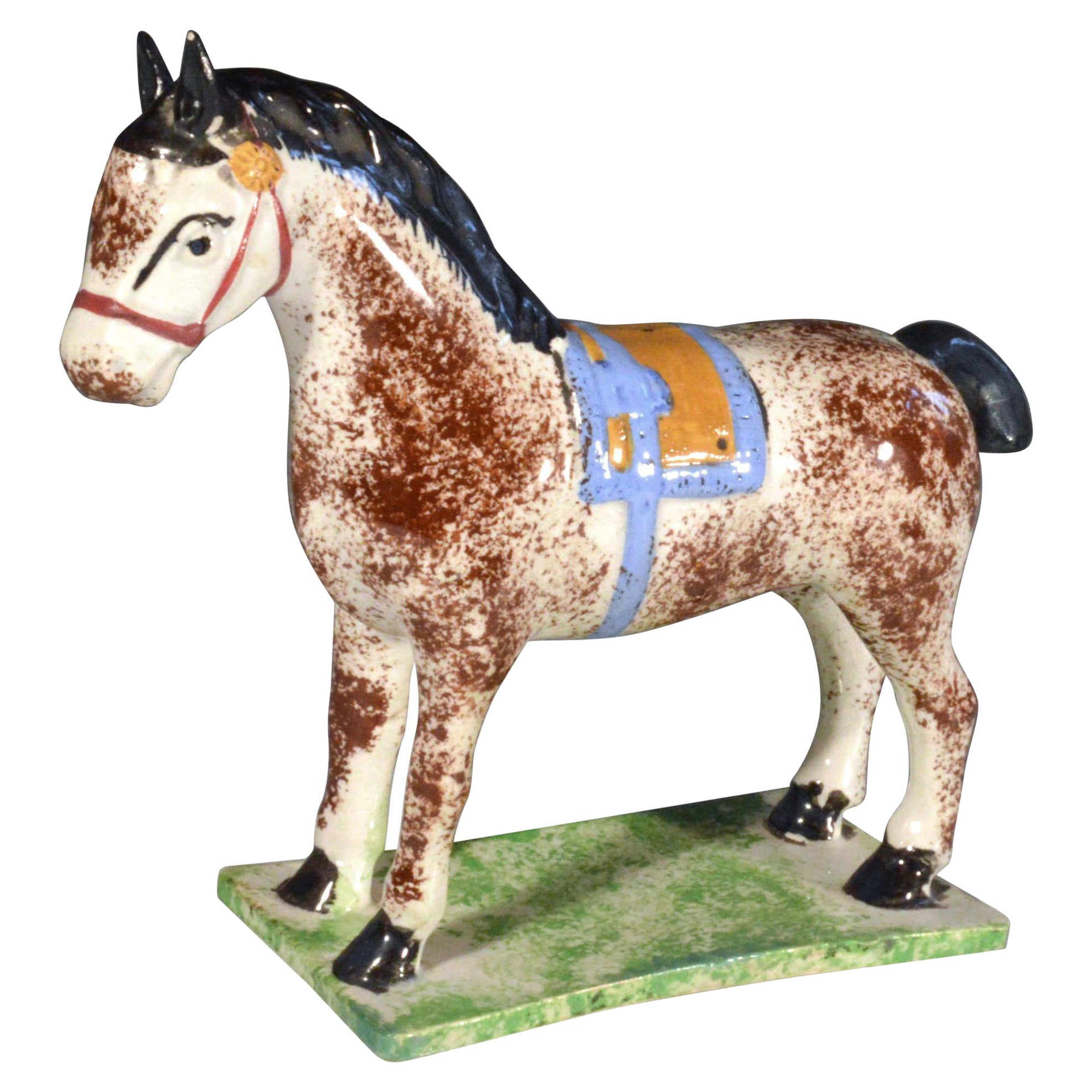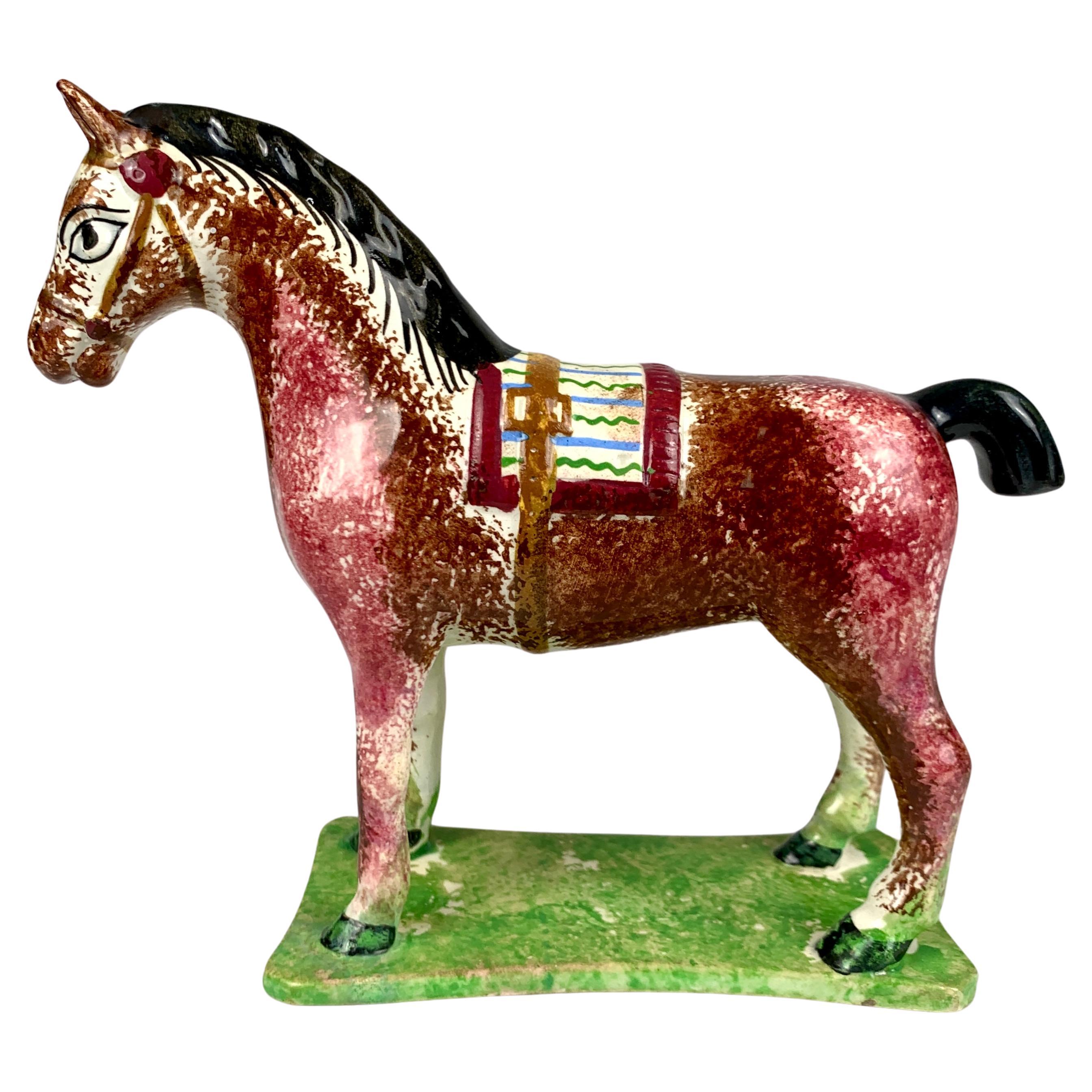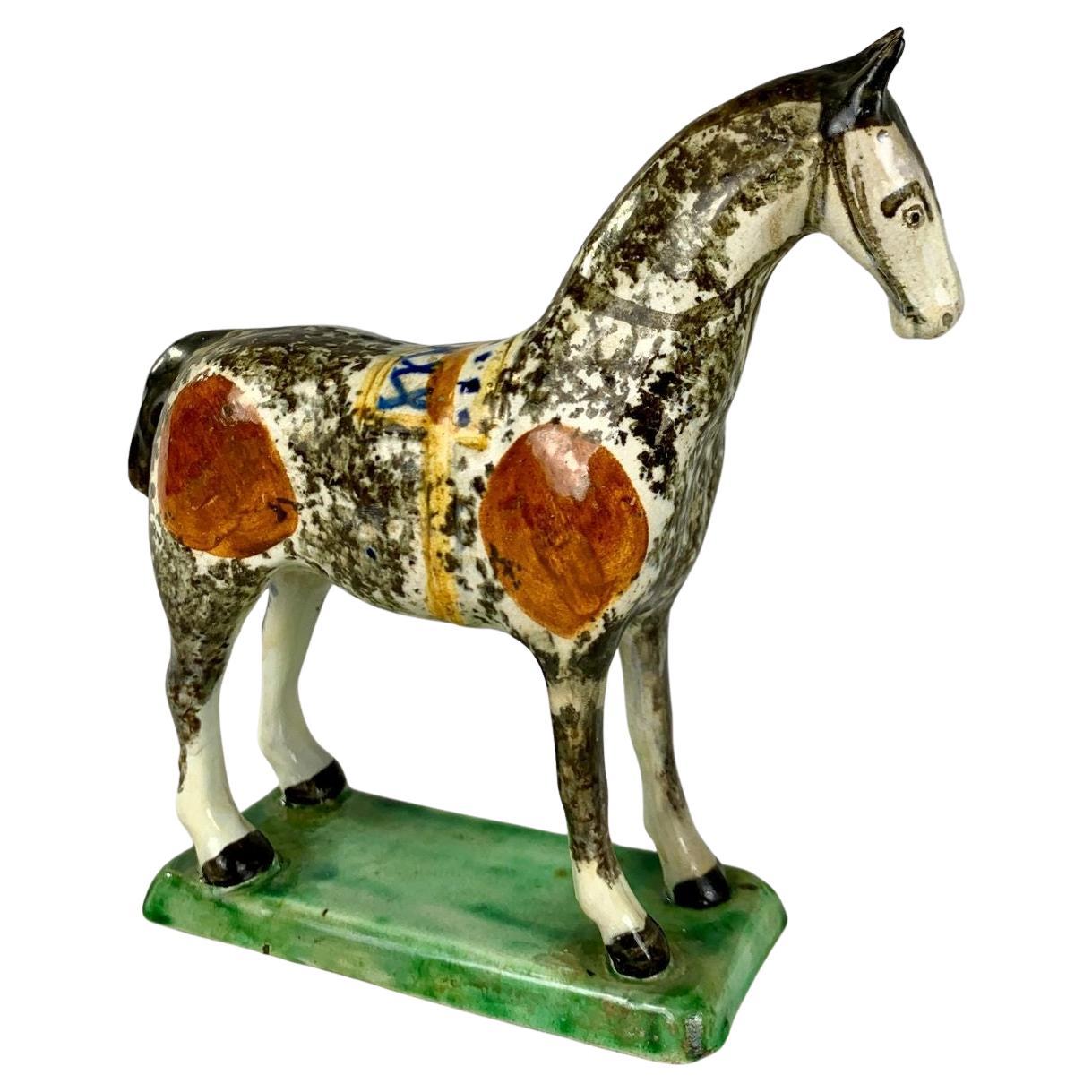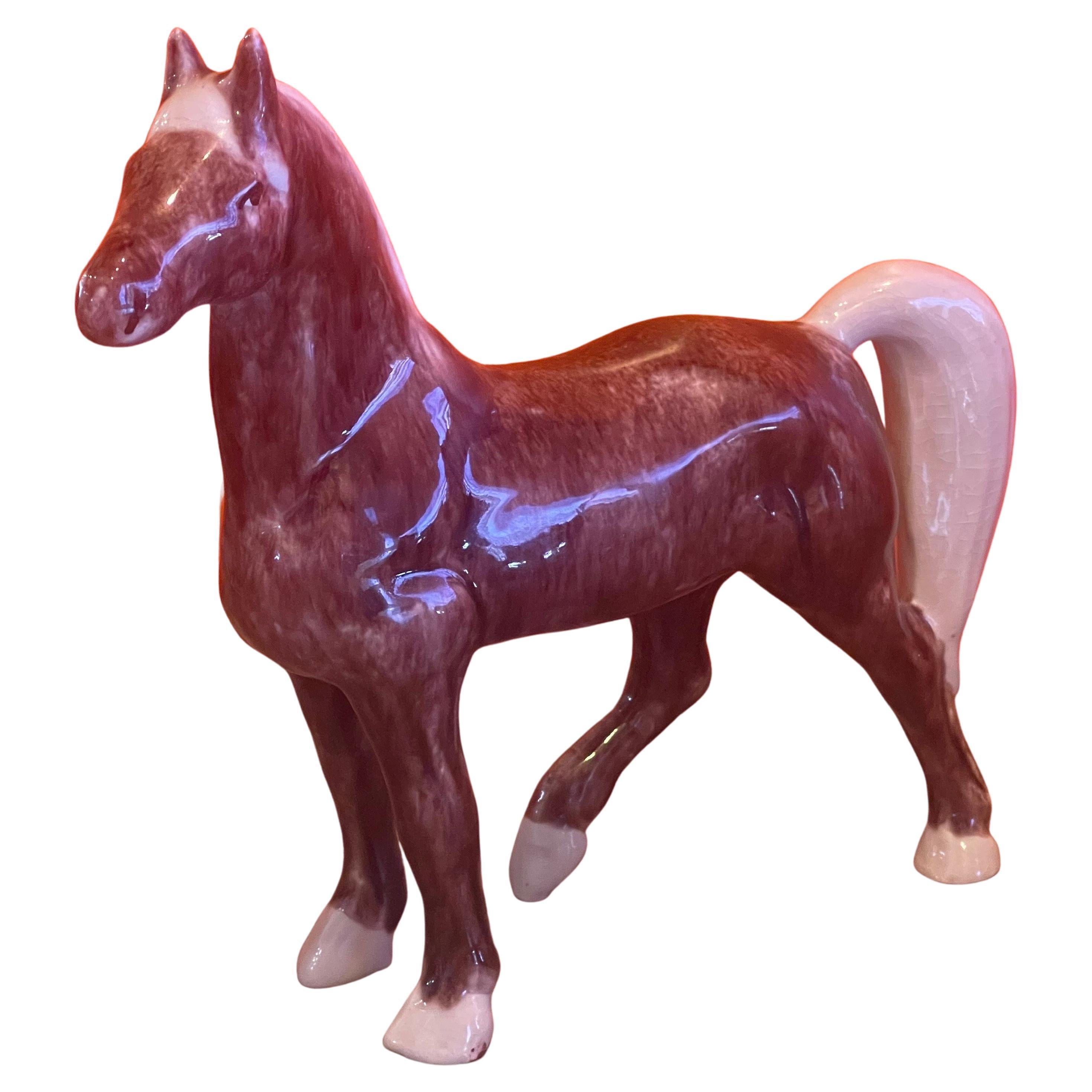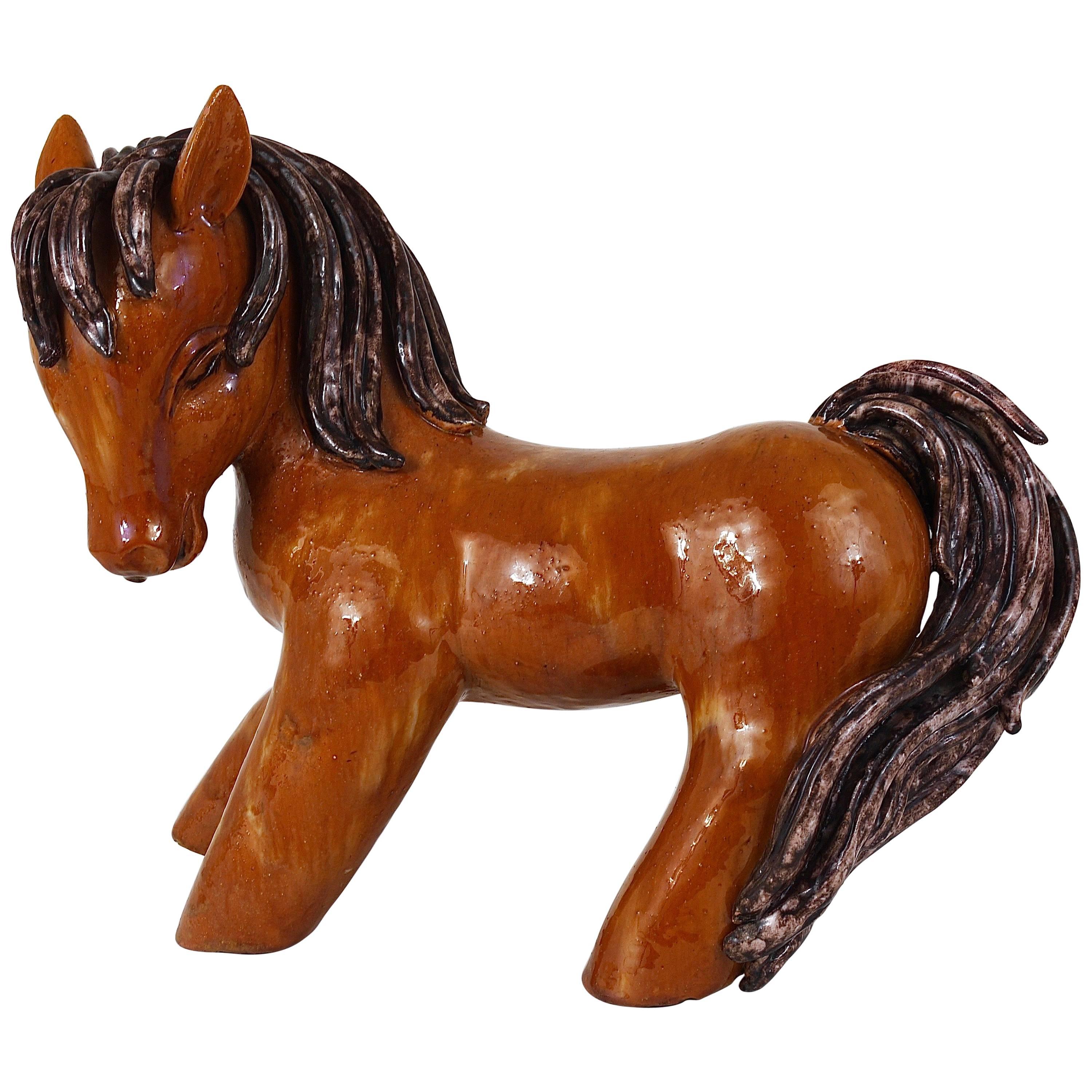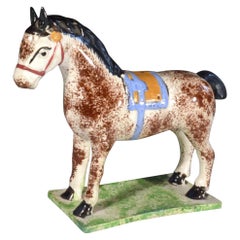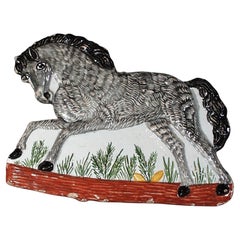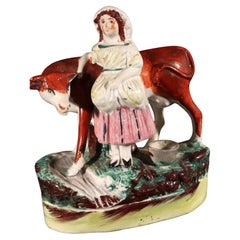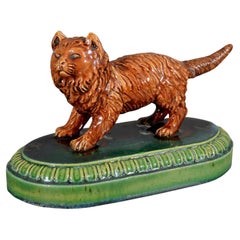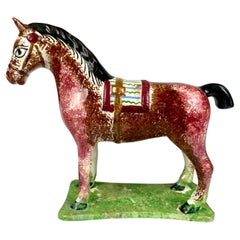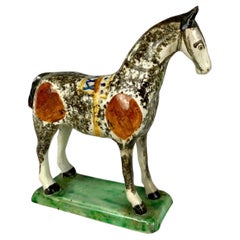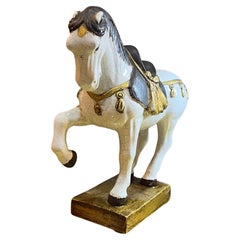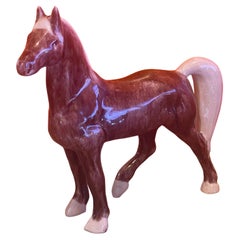Items Similar to Newcastle Prattware Pottery Model of a Horse, St. Anthony Pottery, Newcastle
Want more images or videos?
Request additional images or videos from the seller
1 of 7
Newcastle Prattware Pottery Model of a Horse, St. Anthony Pottery, Newcastle
$5,500
£4,177.70
€4,814.13
CA$7,745.36
A$8,586.88
CHF 4,512.74
MX$105,089.32
NOK 56,359.54
SEK 52,899.06
DKK 35,934.46
About the Item
Newcastle Prattware Pottery model of a horse,
St. Anthony Pottery, Newcastle upon Tyne,
circa 1800-1820.
The fun, folky horse has a cropped tail stands on a flat mottled green shaped rectangular base. It has an unusual coloring of mottled red and cream body with a blue and yellow saddle cloth and blue strap around its middle.
There is an old D.M P. Manheim Antiques label to the base. (Millie Manheim was the top dealer in the UDA in porcelain and pottery with great taste and style.)
Dimensions: 6 inches x 7 inches x 2 inches
Some horses of this form are marked with an impressed St Anthony mark.
Reference: Prattware 1780-1840, John & Griselda Lewis, page 100 for a similar marked model.
- Creator:Saint Anthony Pottery (Manufacturer)
- Dimensions:Height: 6 in (15.24 cm)Width: 7 in (17.78 cm)Depth: 2 in (5.08 cm)
- Style:Regency (Of the Period)
- Materials and Techniques:
- Place of Origin:
- Period:
- Date of Manufacture:1825
- Condition:Repaired: Old invisible repair to tail (off/on) and tip of ears. Wear consistent with age and use.
- Seller Location:Downingtown, PA
- Reference Number:Seller: ny8687-icmr1stDibs: LU861010644273
About the Seller
5.0
Recognized Seller
These prestigious sellers are industry leaders and represent the highest echelon for item quality and design.
Platinum Seller
Premium sellers with a 4.7+ rating and 24-hour response times
Established in 1916
1stDibs seller since 2009
416 sales on 1stDibs
Typical response time: 3 hours
Associations
The Art and Antique Dealers League of AmericaAntiques Associations Members
- ShippingRetrieving quote...Shipping from: Downingtown, PA
- Return Policy
Authenticity Guarantee
In the unlikely event there’s an issue with an item’s authenticity, contact us within 1 year for a full refund. DetailsMoney-Back Guarantee
If your item is not as described, is damaged in transit, or does not arrive, contact us within 7 days for a full refund. Details24-Hour Cancellation
You have a 24-hour grace period in which to reconsider your purchase, with no questions asked.Vetted Professional Sellers
Our world-class sellers must adhere to strict standards for service and quality, maintaining the integrity of our listings.Price-Match Guarantee
If you find that a seller listed the same item for a lower price elsewhere, we’ll match it.Trusted Global Delivery
Our best-in-class carrier network provides specialized shipping options worldwide, including custom delivery.More From This Seller
View AllNewcastle Prattware Pottery Horse, Attributed to St. Anthony Pottery
By Saint Anthony Pottery
Located in Downingtown, PA
Newcastle Prattware Pottery model of a horse,
Attributed to St. Anthony Pottery, Newcastle upon Tyne,
circa 1800-1810.
The horse with cropped ta...
Category
Antique Early 19th Century English Regency Animal Sculptures
Materials
Pearlware, Pottery
Faience Plaque in the Form of a Horse, circa 1840
By Rörstrand
Located in Downingtown, PA
Continental faience plaque in the form of a horse,
circa 1840,
Probably Rorstrand.
The plaque is amusingly decorated with a galloping gray horse wi...
Category
Antique Mid-19th Century Swedish Early Victorian Decorative Art
Materials
Ceramic, Faience
Staffordshire Pottery Cow Figure with Milkmaid
By Staffordshire
Located in Downingtown, PA
Staffordshire Pottery Cow Figure with Milkmaid,
Circa 1860
The Staffordshire pottery model depicts a cow crossing a small stream. By her s...
Category
Antique 1860s English Victorian Pottery
Materials
Pottery
Majolica Earthenware Model of a Cat, Possibly William Brownfield
By William Brownfield
Located in Downingtown, PA
Majolica Model of a Cat,
Earthenware with Majolica Glaze,
Possibly William Brownfield,
19th Century
The figure of a cat is modeled as an orange-brown cat with almost a mane. It is p...
Category
Antique Late 19th Century Victorian Animal Sculptures
Materials
Earthenware, Majolica
Staffordshire Pearlware Pottery Fox Hound Stirrup Cup
By Staffordshire
Located in Downingtown, PA
Staffordshire Pearlware Pottery Large Fox Stirrup Cup,
Circa 1820
The large pearlware pottery stirrup cup depicts a fox hound. The hound is naturalistically colored in browns and w...
Category
Antique Early 19th Century English Regency Pottery
Materials
Ceramic, Pearlware, Pottery
Staffordshire Pottery Bulldog Stirrup Cup
By Staffordshire
Located in Downingtown, PA
Staffordshire Bulldog Stirrup Cup,
Circa 1820
The pearlware pottery stirrup cup is modeled in the form of a bulldog head and sports an orange collar with a gilt buckle. The dog ha...
Category
Antique Early 19th Century English Regency Pottery
Materials
Ceramic, Pearlware, Pottery
You May Also Like
Antique English Pottery Horse with Sponged Decoration Circa 1800
By Saint Anthony Pottery
Located in Katonah, NY
This pottery figure of a horse is sponge decorated in shades of pink and brown.
It was made at St. Anthony’s Pottery, located in Newcastle Upon Tyne, England, between 1800 and 1810.
...
Category
Antique Early 19th Century English Folk Art Animal Sculptures
Materials
Pottery
Antique Creamware Horse Hand Painted English Folk Art Animal c.1800
By Saint Anthony Pottery
Located in Katonah, NY
This antique English creamware horse was hand-painted at St. Anthony’s Pottery in Newcastle around the year 1800.
This charming figure is modeled in a standing position on a green-gl...
Category
Antique Early 19th Century English Folk Art Animal Sculptures
Materials
Creamware
1960s enamelled terracotta prancing horse
By Ceramiche Zaccacnini
Located in Catania, IT
Zaccagnini prancing horse in enameled terracotta from the 60s. Product in good condition with small wear caused by the years and use. Please carefully view the attached images.
Category
Vintage 1960s Italian Animal Sculptures
Materials
Pottery
$950 Sale Price
20% Off
Vintage Ceramic Horse Sculpture by Dorothy Kindell
By Dorothy Kindell
Located in San Diego, CA
A great handmade ceramic horse sculpture by Dorothy Kindell, circa 1940s. This rare piece is quite large, in good vintage condition (some minor...
Category
Early 20th Century American Animal Sculptures
Materials
Ceramic
$520 Sale Price
20% Off
Walter Bosse Huge Pottery Ceramic Horse Sculpture, Austria, 1950s
By Walter Bosse
Located in Vienna, AT
A lovely and huge handmade figurine / statue displaying a horse dated from 1947 to 1951. Designed by Walter Bosse, made of ceramic / terracotta in Kufst...
Category
Mid-20th Century Austrian Mid-Century Modern Animal Sculptures
Materials
Ceramic, Pottery, Stoneware, Terracotta
Vintage Asian Glazed Ceramic Tang Horse
Located in West Palm Beach, FL
Elevate your decor with this Vintage Asian glazed ceramic Tang horse. Featuring exquisite craftsmanship and a rich glaze, this piece brings an elegant touch of Eastern artistry to yo...
Category
Late 20th Century Chinese Animal Sculptures
Materials
Ceramic
More Ways To Browse
Blue And Brown Pottery
Horse Model
Yellow And Brown Pottery
Red And Blue Pottery
Blue Yellow Pottery
Saddle Sculpture
Green Horse Sculpture
Horse Pottery
Green And Cream Pottery
P M Porcelain
Antique Saddle Stand
Saddle Horse Stand
Antique Prattware
Antique Horse Crop
Prattware Pottery
Newcastle Pottery
Pearlware Horse
John Millie
